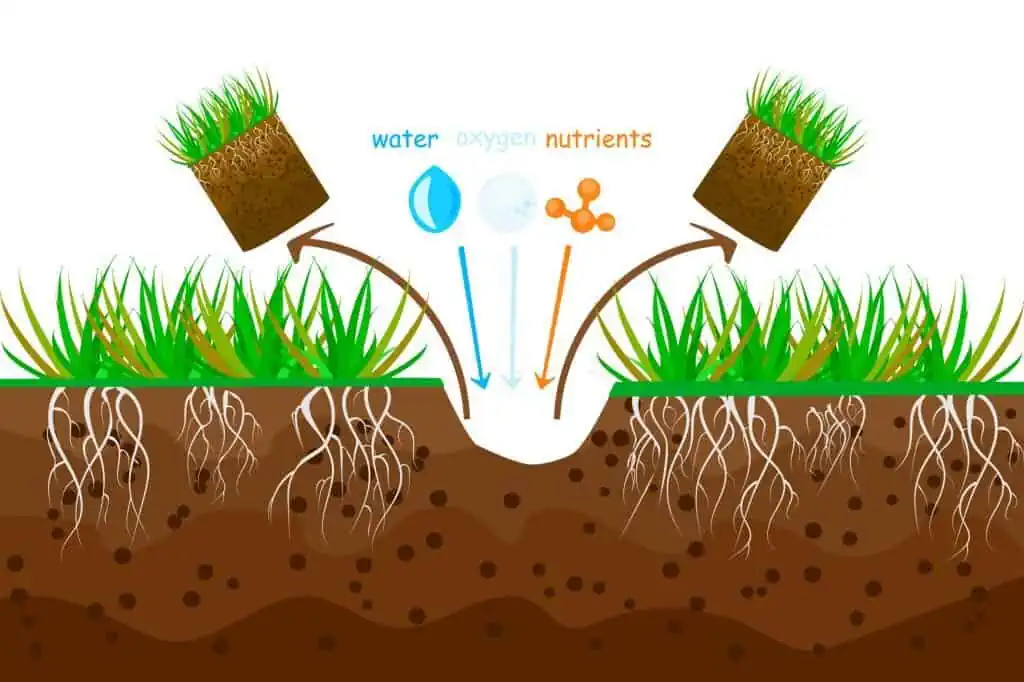Lawn aeration is a process that breathes new life into your lawn and maintains its healthy, green look at all times. If you stay in Utah, you know that winter gets cold while summer delivers a sweltering time, which could get beyond 100° Fahrenheit.
Many people with yards wonder about the best time to aerate their lawn between those seasons. This article has come at the right time if you are considering when to aerate your lawn in Utah. Read on!
Why is Lawn Aeration Important?
Whether you stay in Salt Lake, St. George, Ogden, or other top destinations in Utah, soil compaction can be an issue. Soil compacts due to regular events like kids playing, yard picnics, lawn mowing, and even mere walks over your lawn.
When that happens, the soil prevents the roots of your grass from absorbing the right amount of water and nutrients. It also inhibits lawn growth.

When you aerate your lawn in Utah, the effects of compacted soil are dealt with. Aeration will allow the roots of your grass to regain strength, take in more water, and increase overall greenery. Further, an aerated lawn will drain rainwater more effectively, which reduces the formation of nutrient-poor clay underneath your lawn.
In addition, good lawn aeration increases the effectiveness of other lawn treatments, such as fertilizers and irrigation. Insect damage and other effects also get decrease with proper aeration.
The Best Time to Aerate Lawn in Utah
In Utah, fall and spring are the best times to aerate your lawn. Further, lawns are most used during summer, causing more soil compaction when walked or played on.
During the fall, aerating the soil helps to undo this compaction so that grass thrives throughout the winter. As mentioned earlier, winter also takes a toll on lawns, while extra moisture also leads to compaction, especially for clay soils.
The lawn suffers when the ground and roots are cold for long spells. But when you aerate in spring, it helps to increase the air and water intake to the roots so that they can produce green lawns in the spring.

Signs Your Lawn Needs Aeration
Lawn aeration is a critical part of lawn maintenance. It is not something you need to do every other weekend. That’s why you should watch out for these signs:
- Unhealthy Grass: You will notice unhealthy grass if you pay attention. If your soil is compacted, lawn grass will carry a dehydrated or brown look. That makes your lawn look distressed or old, showing that your grass lacks essential nutrients.
- Thick Thatch Layer: A thick thatch is a layer of organic debris of stems, shoots, and roots that collects on your lawn. While a small layer is beneficial, a thicker layer could present barriers that prevent the penetration of water and nutrients to the grass’s roots.
- Water Puddles or Runoffs: Water will not penetrate the soil if the soil is overly compacted. When that happens, you will spot pools of water or runoffs in different areas of your lawn. It’s time to aerate your Utah lawn.
Steps to Aerate Your Lawn

Lawn aeration is most successful when you follow some steps and guidelines. Follow these steps to get it right:
- Mow Your Lawn: Yes. It looks like a step you save for last, but that’s not the case. Make sure you mow evenly before you start the aerating project.
- Check Your Soil for Signs: Now that you have mowed your lawn, check for signs that show it needs aeration. To do that, dig a square foot section on the edge of your lawn to measure the depth of the roots. Are they shorter than two inches? It’s time to aerate the soil.
- Water the Lawn: Soak your lawn with up to one inch. You can measure how much water you have used on the grass with a tuna can. Put the can in the middle of the grass. Once it gets full, stop watering immediately.
- Avoid Obstacles and Important Equipment: You want to aerate your soil, and at the same time, it’s essential to avoid certain obstacles. For this reason, mark sprinkler heads, underground pipes, and other vital equipment. This way, you don’t run into obstacles while aerating your lawn.
- Now, Aerate the Lawn: Your choice of tools matters; you can use a manual or automatic aerator. Note that manual aerators need significant physical energy, while automatic aerators are motor-driven and are simple to operate. Aerate your lawn at least twice, going in opposite directions each time.
- Leave Plugs Behind: Do not remove the plugs after aerating with the lawn aerator. The plugs will help with the natural growth process and decompose themselves in a week or so.
- Fertilize: This is the logical thing to do immediately after aerating your soil. Apply the correct fertilizer to your lawn to maximize the growth of your lawn in different weather conditions.
- Seeding (Re-seed): Finally, reseed your lawn. Ensure you evenly spread the seeds across the yard, and watch everything come together in time.
Conclusion
Aerating your Utah turf may seem like something other than a priority, but it is a significant step that can considerably boost the health of your grass and the appearance of your landscape.
Now that you know the benefits of aeration, the steps to take, and the ideal time to aerate, you can maintain a green lawn in all weather. However, fall and spring remain the ideal times to aerate lawns in Utah. Take advantage of these times to perform the steps outlined to achieve an exceptional lawn.






